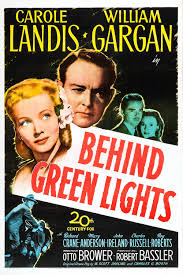
During the night shift Lieutenant Sam Carson (William Gargan) and Detective Oppenheimer (John Ireland) walk out of police headquarters to go for a sandwich. Carson sees a car has rolled up to the steps of the station. Investigating why the car is there he opens the car door and a body falls out. The body is that of low-life criminal Walter Bard (Bernard Nedell). He’s been shot and the gun was found beside him.
Carson launches an investigation. In Bard’s appointment book he finds the name Janet Bradley (Carole Landis). Janet is the daughter of Luther Bradley who is running for Mayor on a reform ticket. Carson has Janet come to the police station for questioning. Dr. G.F. Yager (Don Beddoe) is the medical examiner and is in the room when Carson discovers that Janet knew Bard. He runs to his office and calls Bradley’s political rival Max Calvert (Roy Roberts), the publisher of the city paper “The Express”.
Janet fully admits she had gone to see Bard. She refuses to say why. Carson takes her finger prints and has her wait. While she is waiting Calvert shows up hinting that Carson should book Janet even if there is no evidence that she had anything to do with Bard’s death. Bad publicity for the family could mean Bradley loses the election. That would be good for Calvert since he is the one running against Carson.
Oppenheimer finds that Janet’s prints are on the gun and on a glass in Bard’s apartment. Janet then admits that she was delivering a blackmail payment to the man but only had half the money. She refuses to say for whom. Bard says he has a customer who will pay full price. Janet manages to get the blackmail information from him at gun point but she says he was alive when she left. She says she tossed his gun in his car on the way out. This does not bode well for Janet.
Yager tells Calvert that Bard actually died by poison. Calvert wants this information under wraps. Since Yager is corrupt it doesn’t take much for him to go along with Calvert’s harebrained plan. What they don’t count on is a small time inmate inadvertently throwing a monkey wrench in their plans. More witnesses come out of the woodwork and Carson has to put all the pieces together and figure out the good guys from the bad guys.
“Behind Green Lights” was released in 1946 and was directed by Otto Brower. It is an American film noir and a police procedural. It’s a good “B” mystery produced by Twentieth Century Fox. Considering the entertainment value It’s more obscure than it should be.
It’s a quick moving film and just a little over an hour long. The movie is actually quite dated which in this case adds to the entertainment value. It makes it campy enough to be fun. The actors are talented and the script taut. There’s also some silliness that actually adds to the film. The main comic relief is in the form of a flower lady named Flossie (Mabel Paige) who is a little on the over the top side. Other than that you like the characters you’re supposed to like and you hate the characters you’re supposed to hate. Everything else is on point and flows nicely. Blackmail, cover-ups, political shenanigans. What’s old is new again.
The best part of the film is the two leads in the form of Lieutenant Carson and Janet Bradley. There is an attraction between the two that is organic. They don’t swoon over each other right away but there is a slow and natural attraction between the two that slowly forms.
If you’re a fan of Carole Landis you might be a little disappointed in this film. She doesn't have that much to do. Carole spends most of her time sitting in a room waiting or being questioned by the police. Carole did a lot of comedies and musicals as well as playing Loana in “One Million B.C.” 1940 with Victor Mature.
Richard Crane from the television series “Rocky Jones, Space Ranger” has a small part as a news reporter named Johnny Williams.
The meaning behind, “Behind Green Lights” has to do with the lights in front of police stations. Apparently the custom is still practiced outside New York City police precincts. Supposedly even new precincts have two green lights flanking their entrance. The tradition goes back to 1658. The story goes: Peter Stuyvesant established an eight-member “rattle watch” who were “paid a small sum to keep an eye on the growing, bustling town,” and look out for pirates, vagabonds, and robbers. The rattle watchmen carried green lanterns over their shoulders on a pole, like a hobo stick, so residents could identify them in the dark, unlit streets. “When the watchmen returned to the watch house after patrol, they hung their lantern on a hook by the front door to show people seeking the watchman that he was in the watch house. Today, green lights are hung outside the entrances of police precincts as a symbol that the ‘watch’ is present and vigilant.”

